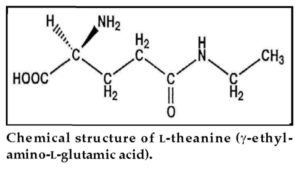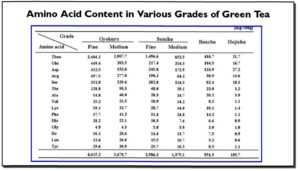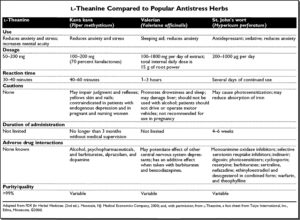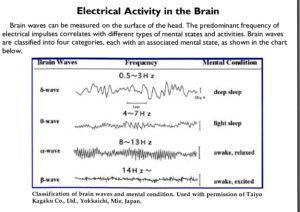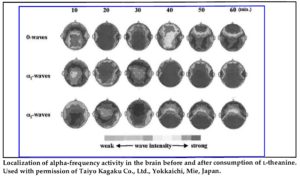200 mg of Zen
L-Theanine Boosts Alpha Waves, Promotes Alert Relaxation
It is probably no surprise to learn that tea is—after water—the most consumed beverage in the world. Millions of people drink this soothing beverage, especially in the East, and its popularity continues to grow in the West. Of course, Oriental cultures have known about tea’s medicinal benefits since andent times and have used it as a general purpose tonic—and for its relaxation effects.
While there are hundreds of studies that dearly show the health benefits of tea (see box entitled Health Benefits of Green Tea), most people drink it because it Iras a pleasant flavor and a relaxing effect. This relaxing effect is caused by the presence of a neurologic ally active amino acid, l-theanine, found almost exclusively in tea plants (Camellia sinensis), in Xerocomus badius mushrooms, and in certain species of the genus Camellia, namely C. japonica and C. sasanqua.
Research with human volunteers has affirmed that L-theanine not only creates a sense of relaxation approximately 30-40 minutes after oral ingestion but that it accomplishes this via two different avenues of approach. First, this amino acid stimulates production of alpha brain waves directly, creating a state of deep relaxation and mental alertness such as is often achieved via meditation. Second, L-theanine appears to have a role in the formation of the inhibitory neurotransmitter gamma amino butrylic acid (GABA). GABA blocks release of the neurotransmitters dopamine and serotonin and may, therefore, have the key role in the relaxation effect.1
In 1999, scientists at the Laboratory of Nutritional Biochemistry, School of Food and Nutritional Sciences, the University of Shizuoka, in Shizuoka, Japan, were able to confirm several unique properties of L-theanine.2 Their research suggested that, in addition to facilitating relaxation, L-theanine (or the trade-marked product, Suntheanine,™ from Taiyo Kagaku, Co., Ltd., in Yokkaichi, Mie, Japan) may also have applications in: (1) controlling hypertension; (2) improving learning performance; (3) heightening mental acuity; (4) promoting concentration; (5) reducing caffeine effects; and, (6) supporting the immune system.3
L-theanine constitutes between 1 and 2 percent of the dry weight of tea leaves, is the predominant amino-acid component in tea, and exists only in the free (nonprotein) form. The presence of l-theanine in tea leaves was discovered by Japanese researchers in 1949 and its
chemical structure was determined to be gamma-ethylamino-L-glutamic acid. By 1964, after favorable toxicology studies, L-theanine was approved in Japan for unlimited use in all foods, with the exception of infant foods.2‘4 It is L-theanine that gives tea its characteristic, slightly brothy, umami taste. (See box entitled Umami or “5th Taste.”)
Interestingly, the L-theanine content of certain specialty teas often correlates with the grade of tea. High-grade
A study of more than 3000 Japanese women
who drank more than usual amounts of tea indicated
that tea may be a protective factor against premature death.
Health Benefits of Green Tea
A 1992 article published in the Tohoku Journal of Experimental Medicine reviewed mortality rates of more than 3000 Japanese women who, as practitioners of a specific tea ceremony, drank more than usual amounts of tea. The results indicated “the possibility that tea is a protective factor against premature death.”3
Research has also shown that tea is rich in catechin polyphenols, particularly epigallocatechin gallate (EGCG)—a powerful antioxidant)3 The cancer-preventive and cancer-inhibiting effects of EGCG have been major foci of cancer research in recent years.3 Research has also shown that EGCG is effective in lowering low-density lipoprotein cholesterol levels, thus, inhibiting the abnormal formation of blood clots—the leading cause of heart attacks and stroke.31‘6
sSadakata, S., Fukao, A, Hisamichi, S. Mortality among female practitioners of Chanoyu (Japanese tea-ceremony). Tohoku J Exp Med. 166:475-477. l992;bNakagawa, K, Ninomiya, M., Okubo, T., Aoi. N.,Juneja, L.R., Kim, M., Yamanaka, K, Miyazawa, T. Tea catechin supplementation increases antioxidant capacity and prevents phospholipid hydroperoxidation in plasma of humans.J Agric Food Chem 47:3967-3973, l999;cSuganuma, M., Okabe, S., Sueoka, N., Sueoka, E., Matsuyama, S., Imai. K., Nakachi, K, Fujiki, H. Green tea and cancer chemoprevention.Mutot Res 428 (l-2):339-344, 1999; d Ahmad N., Mukhtar, H. Green tea polyphenols and cancer Biologic mechanisms and practical implications. Nutr Rev 57:78-83, 1999; eKang, W.S., Lim, I.H., Yuk, Y., Chung K.H., ParkJ.B., Yoo, H.S, Yun, Y.P. Antithrombotic activities of green tea catechins and (-)-epigallocatechin gallate. Thromb Res 96:229-237, 1999.
L-Theanine is still comparatively unknown in the United States.
matcha green tea, which is one of the most expensive types of green tea, has the greatest percentage of L-theanine. Gyokuro and sencha green teas also contain fairly high amounts—between 26 and 46 mg of L-theanine per cup of tea. However, according to Scott Smith, senior manager at Taiyo International, Inc., the Edina Minnesota-based U.S. distributor for Taiyo Kagaku, other kinds of non-green tea also have high L-theanine contents. These include Ceylon pekoe from Sri Lanka, Darjeeling, and Earl Grey from China. The amount of L-theanine in tea depends on a variety of environmental factors, including climate, rainfall, and sunlight where the plant is grown.
Although scientists were aware of the physical and neurologic benefits associated with drinking tea, until 1990, there was no economically viable method for producing L-theanine. That is because extracting the amino acid from the leaves was a difficult, expensive, and inefficient process: It took a lot of tea leaves to yield a small quantity of L-theanine. Then, in 1990, food scientists at Taiyo Kagaku, in Japan, developed an enzymatic process for making a compound that is chemically identical to the L-theanine found in tea. The enzymatic process requires slow fermentation and it takes approximately 4 months to make one batch. However, pharmaceutical grade (>99 percent purity) L-theanine is the result and it does not require a mountain of tea leaves.
Once the process for creating L-theanine was standardized, Taiyo Kagaku trademarked the product as Sunthea-nine. After favorable toxicology studies, including the 28 Day Subacute Toxicity Study, the 78 Week Evaluation of Toxicity and Carcinogenicity, the Acute Toxicity/LD5q Determination, and the Ames Salmonella Mutagenicity tests, Suntheanine was shown to be safe for use as directed. Studies at Japanese universities, cited below, soon followed.
Umami or “5th Taste”
L-Theanine has the ability to improve the taste of processed foods and beverages, and is especially effective against certain bitter notes, including chocolate, zinc, caffeine, ginseng, grapefruit, and antioxidants.
The effect is caused by the so-called umami or “5th taste” (besides the four traditional tastes: sweet, salty, acid, and bitter). The umami is not particularly strong, but it is able to communicate to specific detecting cells a “mouthfeel” that significantly influences the taste perception. It is a signal for proteins, informing the brain of the availability of a source of essential nutrients. The umami is particularly effective when ribonucleotides, glutamic acid, and amino acids occur contemporaneously in a food or are added to it: This is a combination traditionally and empirically achieved in recipes around the world.
Sources: Ref. 3 and www.biocybernaut.com/publications/history.html
Historically, the roots of alpha brain-wave feedback training lie in a discovery made in 1908 by an Austrian psychiatrist, Hans Berger, M.D. He discovered the existence of oscillating electrical waves in the brain and he called them alpha waves because they were the first electrical activity to be discovered in the brain.
Dr. Berger also discovered that alpha waves were uncommon in anxious people and, if an anxious person did have a few alpha waves, they were smaller than usual (a weaker signal with lower amplitude). After he published his findings in 1918, interest in electrical waves in the brain spread rapidly around the world. Early scientists mapped the different types of brain waves (alpha, beta, delta, and theta), and began to do psychophysical studies on the “natural reactivity” of these brain waves to sensory stimulation.)
Studies consistently support the conclusion
that consumption of 200 mg of L-theanine results in an
increase of alpha-wave activity in the brain within 30-40 minutes.
Caffeine
Caffeine is a trimethyl derivative of purine 2,6-diol and is synthesized in the leaves of the tea plant. The occurrence of caffeine was first observed by Runge in 1820. Nakabayashi isolated a similar compound from tea and named
it theine. Later, caffeine and theine were identified to be the same compound. The caffeine content of coffee beans is usually 1.5 percent, while that of green tea reaches a maximum of 5 percent.5
Tea has earned a popular reputation for having less caffeine than coffee because the L-theanine in the tea actually lessens the stimulant effect of caffeine on the human nervous system. As a result, tea— especially green tea—has gained in popularity as a beverage that has a calming, or relaxing effect.
Japanese scientists were fairly certain that it was the amino acid L-theanine that created this relaxation effect but had no research to support their hypotheses. Once Taiyo Kagaku had developed and standardized a process for producing L-theanine, it was possible for researchers to begin basic research with human volunteers. During the 1970s and 1980s, Japanese researchers investigated the influence of alkylamides of
L-Theanine Products
In the United States, Taiyo Kagaku, Co., Ltd., the manufacturer of L-theanine (Suntheanine) is represented by:
Taiyo International, Inc.
4700 West 77th Street, Suite 175
Edina, MN 55435
(952) 832-5273
While L-theanine is still comparatively unknown in the United States, in Japan, it is not only marketed in capsule form, it also appears in more than fifty products, which include beverages, ice cream, jelly, candy, and gum—all created to induce relaxation.
Taiwan, Korea, and Europe also have products that contain Suntheanine. In the United States, the capsule form of Suntheanine is available from Weider Nutrition (Salt Lake City, Utah), Swanson Health Products (Fargo, North Dakota), Doctor’s A-Z (Fargo, North Dakota), BioSynergy (Boise, Idaho), and Atkins Nutritionals (Ronkonkoma, New York).
Taiyo has determined that L-theanine does not degrade in beverages heated at I2I°C for 5 minutes and is stable in solution with a pH between 3.0 and 6.6. With its excellent stability over a range of temperature and pH conditions, L-theanine can be formulated into candies, herb tea, cocoa drinks, various beverages, chocolates, puddings, jellies, chewing gums, and other snacks.
As of this writing, there are no food products marketed in the United States that contain L-theanine; approval is being sought.
Biosynthesis of L-Theanine and Its Metabolism in the Tea Plant
L-Theanine is synthesized in the root of the tea plant starting from ammonium as the nitrogen source. The glutamic acid produced in the root conjugates with ethylamine by the catalytic reaction of L-glutamate ethylamine ligase. Ethylamine is derived from alanine by decarboxylation or de novo synthesis via pyruvic acid. It is known that Camellia sinensis produces ethylamine from alanine.
L- Theanine synthesized in the root is immediately transferred to growing shoots and accumulated there. A remarkable accumulation of theanine in buds and young leaves is caused by the continuous transport of it from roots, because the catabolism of theanine in young shoots is slow relative to the transportation rate of theanine.
L-Theanine accumulated in young shoots is hydrolyzed into glutamic acid and ethylamine by an enzyme. The ethylamine produced is used to synthesize catechins under the sunlight. A part of ethylamine is degraded into acetaldehyde, hydrogen peroxide, and ammonia by an enzymatic oxidation reaction. The released ammonia is used as a nitrogen source again.
Courtesy of Taiyo International, Inc., Edina, MN; Adapted with permission from reference 3.
L-Theanine does not make patients drowsy nor does it promote sleep—this amino acid does not produce theta waves.
glutamic acid and related compounds on the central nervous system and the effects of L-theanine on mice and rats.2,6,7
L-Theanine Stimulates Alpha-Wave Activity in the Brain
A volunteer study was undertaken to investigate the mental response to L-thea-nine.2 Because it was anticipated that the mental response could vary with an individual’s anxiety level, test subjects (18-22 years old) were divided into high-anxiety and low-anxiety groups, as determined by the Manifest Anxiety Scale. Tests were conducted on four high-anxiety and four low-anxiety subjects. Over a 2-month period, each volunteer was given test solutions of water, water containing 50 mg of L-theanine, or water containing 200 mg of L-theanine. Brain waves were measured for 60 minutes after each administration. The experiment indicated that alpha brain waves were observed from the back to the top surface of a person’s head within approximately 40 minutes after the subject had taken the L-theanine solutions.
In a separate study8 it was noted that “[thejhe intensity of alpha waves were determined to be dose dependent and detectable after thirty minutes. The perceived relaxation effect was incidental with the detection of alpha waves.” These results are consistent with the previously mentioned study,1 which reported that L-theanine reached the brain within 30 minutes.
These studies consistently support the conclusion that consumption of 200 mg of L-theanine results in an increase of alpha-wave activity in the brain within 30-40 minutes. This fosters a state of alert relaxation. (See box entitled Electrical Activity in the Brain.)
Stress Control Products
Stress and anxiety are debilitating conditions that can shorten one’s life while lessening performance, well-being, and the overall enjoyment of activities. Stress can also
impair the ability to perform mental tasks and may also result in reactions to situations that cause frustration, hostility, and damage. Stress can impair the immune system, thus lowering resistance to disease and creating the possibility for opportunistic diseases to occur. Stress can also cause depression.
According to the National Institutes of Health, in any given 1-year period, 9.5 percent of the population, or about 18.8 million American adults, suffer from depressive illness.9 In 1998, pharmaceutical sales of antidepressants totaled $4.79 billion; sales of anxiety drugs totaled $722 million. The annual sales of antistress herbs, such as kava kava (Piper methysticum), St. John’s wort (Hypericum perforatum) and valerian (Valeriana officinalis), totaled $83.2 million for the period ending April 199910
L-Theanine Versus Antistress Herbs
The principal difference between L-theanine and antistress herbs is that L-theanine does not make patients drowsy nor does it promote sleep—this amino acid does not produce theta waves.
This is significant. People who are in stressful situations—whether they are environmental, personal, or medical in origin—can mitigate the harmful effects of stress significantly with L-theanine, without becoming sedated in the process. As mentioned previously, research studies have not only confirmed L-theanine’s safety; there is a very long history of its consumption in tea. Unlike other orally administered amino acids, L-theanine is not affected (either positively or negatively) by the consumption of food and may be taken at any time. It should also be noted that if one is already relaxed, the taking of L-theanine will not produce further relaxation.
Conclusion
Currently, L-theanine is available in the United States only in capsule form. As the U.S market comes to appreciate
this benevolent—and powerful—component of green tea, there is likely to be a proliferation of L-theanine-enriched foods and beverages, such as are sold in Japan today. I~1
References
1. Kimura, R., Murata, T. The influence of alky-lamides of glutamic acid and related compounds on the central nervous system: I. Central depressant effect of theanine. Chem Pharm Bull (Tokyo) 19:1257-1261,1971.
2. Juneja, L., Chu, D.-C., Okubo, T., et al. L-Theanine—a unique amino acid of green tea and its relaxation effect in humans. Trends Food Sci Tech 10:199-204,1999.
3. Information sheet. Edina, MN: Taiyo International, Inc., undated.
4. Yokogoshi, H., Mochizuki, M., Saitoh, K. L-Theanine-induced reduction of brain serotonin concentration in rats. Biosci Biotechnol Biochem 62:816-817,1998.
5. Yamamoto, T. (ed.) Chemistry and Applications of Green Tea. Boca Raton: CRC Press, 1997.
6. Kimura, R., Murata, T. Influence of alky-lamides of glutamic acid and related compounds on the central nervous system: IV. Effect of theanine on adenosine 3′, 5′-monophosphate formation in rat cerebral cortex. Chem Pharm Bull (Tokyo), 28:664-666, 1980.
7. Kimura, R., Murata, T. Effect of theanine on norepinephrine and serotonin levels in rat brain Chem Pharm Bull (Tokyo) 34:3053-3077, 1986.
8. Ito, K., Nagato, Y., Aoi, N. Juneja, L.R., Kim, K., Yamamoto, T., Siugimoto, S., Effects of L-theanine on the release of alpha-brain waves in human volunteers. Nippon Nogeika-gaku Kaishi 72:153,1998.
9. www.nimh.nih.gov/publicat/depression, cfm 2000.
10. Schutt, E. Stress reducing herbs. Nutraceu-ticals World 2(5):46,1999.
To order reprints of this article, write to or call: Karen Ballen, ALTERNATIVE & COMPLEMENTARY THERAPIES, Mary Ann Liebert, Inc., 2 Madison Avenue, Larchmont, NY 10538-1961, (914) 834-3100.
This article has been cited by:
1. Quan V Vuong, Michael C Bowyer, Paul D Roach. 2011. L-Theanine: properties, synthesis and isolation from tea. Journal of the Science of Food and Agriculture 91:11,1931-1939. [CrossRef]
2. Akiko Higashiyama, Hla Hla Htay, Makoto Ozeki, Lekh R. Juneja, Mahendra P. Kapoor. 2011. Effects of 1-theanine on attention and reaction time response. Journal of Functional Foods 3:3,171-178. [CrossRef!
3. Zhengzhu Zhang, Xiaochun Wan, Daxiang LiChemistry and Biological Properties of Theanine 20083259, 255-274. [CrossRef]
4. Luke G. Huber . 2003. Green Tea Catechins and L-Theanine in Integrative Cancer Care: A Review of the Research. Alternative and Complementary Therapies 9:6,294-298. [Citation] [Pull Text PDF] [Full Text PDF with Links]
